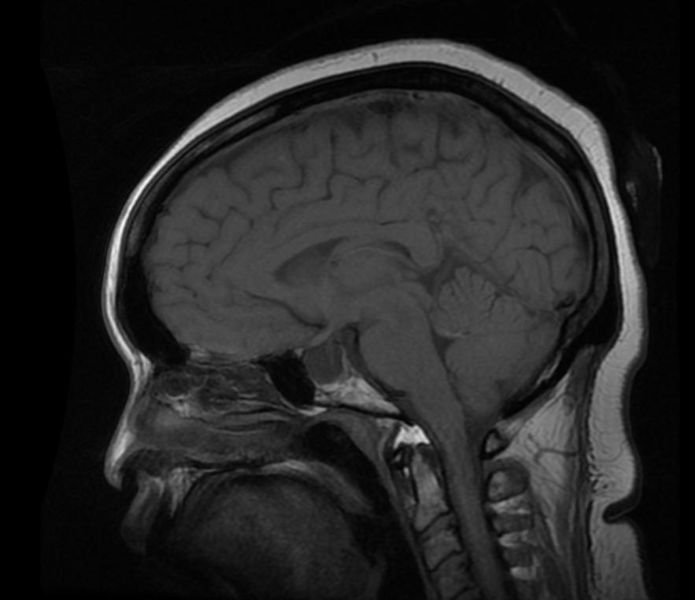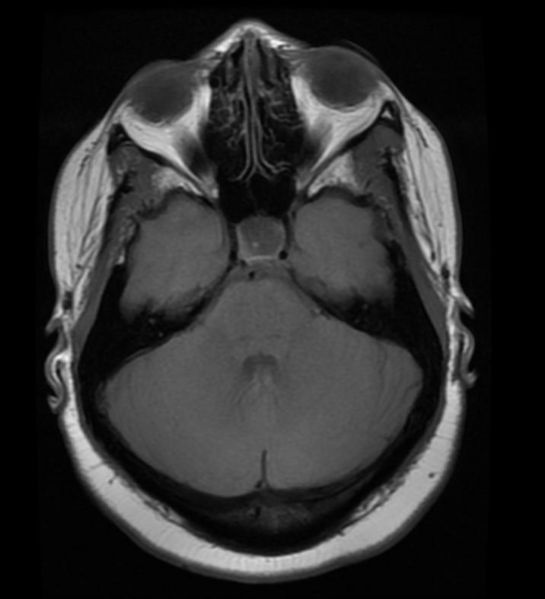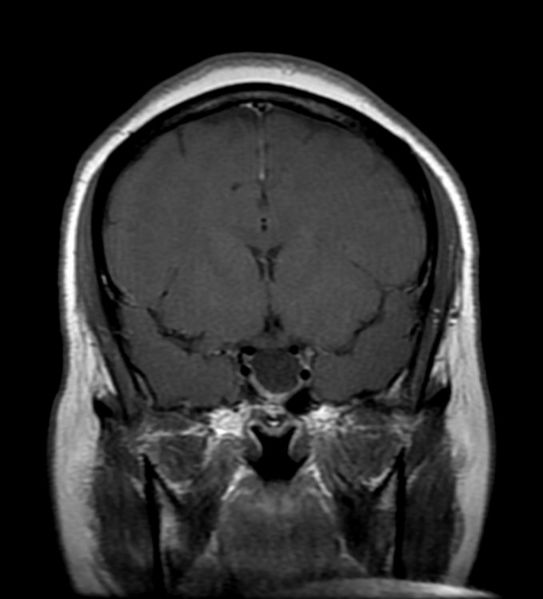Empty sella syndrome: Difference between revisions
Iqra Qamar (talk | contribs) No edit summary |
Iqra Qamar (talk | contribs) |
||
| Line 52: | Line 52: | ||
== Differentiating Empty sella syndrome from other diseases: == | == Differentiating Empty sella syndrome from other diseases: == | ||
Empty sella syndrome needs to be differentiated from other diseases causing hypopituitarism: | Empty sella syndrome needs to be differentiated from other diseases causing [[hypopituitarism]].<ref name="pmid9541295">{{cite journal |vauthors=Sato N, Sze G, Endo K |title=Hypophysitis: endocrinologic and dynamic MR findings |journal=AJNR Am J Neuroradiol |volume=19 |issue=3 |pages=439–44 |year=1998 |pmid=9541295 |doi= |url=}}</ref><ref name="pmid7758238">{{cite journal |vauthors=Powrie JK, Powell M, Ayers AB, Lowy C, Sönksen PH |title=Lymphocytic adenohypophysitis: magnetic resonance imaging features of two new cases and a review of the literature |journal=Clin. Endocrinol. (Oxf) |volume=42 |issue=3 |pages=315–22 |year=1995 |pmid=7758238 |doi= |url=}}</ref><ref name="pmid26262437">{{cite journal |vauthors=Honegger J, Schlaffer S, Menzel C, Droste M, Werner S, Elbelt U, Strasburger C, Störmann S, Küppers A, Streetz-van der Werf C, Deutschbein T, Stieg M, Rotermund R, Milian M, Petersenn S |title=Diagnosis of Primary Hypophysitis in Germany |journal=J. Clin. Endocrinol. Metab. |volume=100 |issue=10 |pages=3841–9 |year=2015 |pmid=26262437 |doi=10.1210/jc.2015-2152 |url=}}</ref><ref name="pmid7629223">{{cite journal |vauthors=Thodou E, Asa SL, Kontogeorgos G, Kovacs K, Horvath E, Ezzat S |title=Clinical case seminar: lymphocytic hypophysitis: clinicopathological findings |journal=J. Clin. Endocrinol. Metab. |volume=80 |issue=8 |pages=2302–11 |year=1995 |pmid=7629223 |doi=10.1210/jcem.80.8.7629223 |url=}}</ref><ref name="pmid8345854">{{cite journal |vauthors=Imura H, Nakao K, Shimatsu A, Ogawa Y, Sando T, Fujisawa I, Yamabe H |title=Lymphocytic infundibuloneurohypophysitis as a cause of central diabetes insipidus |journal=N. Engl. J. Med. |volume=329 |issue=10 |pages=683–9 |year=1993 |pmid=8345854 |doi=10.1056/NEJM199309023291002 |url=}}</ref><ref name="pmid21668725">{{cite journal |vauthors=Hsieh CY, Liu BY, Yang YN, Yin WH, Young MS |title=Massive pericardial effusion with diastolic right ventricular compression secondary to hypothyroidism in a 73-year-old woman |journal=Emerg Med Australas |volume=23 |issue=3 |pages=372–5 |year=2011 |pmid=21668725 |doi=10.1111/j.1742-6723.2011.01425.x |url=}}</ref><ref name="pmid9747750">{{cite journal |vauthors=Dejager S, Gerber S, Foubert L, Turpin G |title=Sheehan's syndrome: differential diagnosis in the acute phase |journal=J. Intern. Med. |volume=244 |issue=3 |pages=261–6 |year=1998 |pmid=9747750 |doi= |url=}}</ref> | ||
<small> | |||
{| class="wikitable" | |||
! rowspan="3" style="background: #4479BA; width: 200px;" | {{fontcolor|#FFF|Diseases}} | |||
! rowspan="3" style="background: #4479BA; width: 200px;" | {{fontcolor|#FFF|Onset}} | |||
! colspan="5" style="background: #4479BA; width: 200px;" | {{fontcolor|#FFF|Manifestations}} | |||
! colspan="4" style="background: #4479BA; width: 200px;" | {{fontcolor|#FFF|Diagnosis}} | |||
|- | |||
! colspan="4" style="background: #4479BA; width: 200px;" | {{fontcolor|#FFF|History and Symptoms}} | |||
! rowspan="2" style="background: #4479BA; width: 200px;" | {{fontcolor|#FFF|Physical examination}} | |||
! rowspan="2" style="background: #4479BA; width: 200px;" | {{fontcolor|#FFF|Laboratory findings}} | |||
! rowspan="2" style="background: #4479BA; width: 200px;" | {{fontcolor|#FFF|Gold standard}} | |||
! rowspan="2" style="background: #4479BA; width: 200px;" | {{fontcolor|#FFF| Imaging}} | |||
! rowspan="2" style="background: #4479BA; width: 200px;" | {{fontcolor|#FFF|Other investigation findings}} | |||
|- | |||
! style="background: #4479BA; width: 200px;" | {{fontcolor|#FFF| Trumatic delivery}} | |||
! style="background: #4479BA; width: 200px;" | {{fontcolor|#FFF| Lactation failure}} | |||
! style="background: #4479BA; width: 200px;" | {{fontcolor|#FFF| Menstrual irregularities}} | |||
! style="background: #4479BA; width: 200px;" | {{fontcolor|#FFF| Other features}} | |||
|- | |||
![[Sheehan's syndrome]] | |||
|Acute | |||
|<nowiki>++</nowiki> | |||
| ++ | |||
|[[Oligomenorrhea|Oligo]]/[[amenorrhea]] | |||
|Symptoms of: | |||
* [[Adrenal insufficiency]] | |||
* [[Hypothyroidism]] | |||
| | |||
* [[Breast tissue]] [[atrophy]] | |||
* Decreased [[axillary]] and [[pubic]] hair growth | |||
| | |||
* [[Pancytopenia]] | |||
* [[Eosinophilia]] | |||
* [[Hyponatremia]] | |||
* Low [[fasting plasma glucose]] | |||
* Decreased levels of [[anterior pituitary]] [[hormones]] in blood | |||
| | |||
* Clinical diagnosis | |||
* Most senitive test: Low baseline [[prolactin]] levels w/o response to [[Thyrotropin-releasing hormone|TRH]] | |||
|CT/MRI: | |||
* Sequential changes of pituitary enlargement followed by: | |||
* Shrinkage and [[necrosis]] leading to decreased sellar volume or [[empty sella]] | |||
| | |||
* Pituitary hormone stimulation tests ([[Metoclopramide]] and [[clomiphene citrate]] stimulation tests) | |||
|- | |||
![[Lymphocytic hypophysitis]] | |||
|Acute | |||
|<nowiki>+/-</nowiki> | |||
|<nowiki>+</nowiki> | |||
|[[Oligomenorrhea|Oligo]]/[[amenorrhea]] | |||
| | |||
* Associated with [[autoimmune]] conditions | |||
* Generalized [[headache]] | |||
* Retro-orbital or Bitemporal [[pain]] | |||
* Mass lesion effect such as [[Visual field defect|visual field defects]] | |||
| | |||
* [[Diabetes insipidus|DI]] | |||
* [[Autoimmune]] [[thyroiditis]] | |||
| | |||
* Decreased pituitary hormones([[Gonadotropins]] most common) | |||
* [[Hyperprolactinemia]](40%) | |||
* [[Growth hormone|GH]] excess | |||
| | |||
* [[Pituitary gland|Pituitary]] [[biopsy]]: [[lymphocytic]] [[Infiltration (medical)|infiltration]] | |||
| | |||
* [[CT]] & [[MRI]]: Features of a [[Pituitary gland|pituitary]] [[mass]] | |||
* Diffuse and homogeneous contrast enhancement | |||
|[[Assay|Assays]] for: | |||
* Anti-TPO | |||
* Anti-Tg Ab | |||
|- | |||
![[Pituitary apoplexy]] | |||
|Acute | |||
|<nowiki>+/-</nowiki> | |||
|<nowiki>++</nowiki> | |||
|[[Oligomenorrhea|Oligo]]/[[amenorrhea]] | |||
|Severe [[headache]] | |||
* [[Nausea and vomiting]] | |||
* Paralysis of eye muscles ([[diplopia]]) | |||
* Changes in vision | |||
| | |||
* [[Visual acuity]] defects | |||
* [[Cranial nerve palsies|CN palsies]] (nerves III, IV, V , and VI) | |||
| | |||
* Decreased levels of [[anterior]] pituitary hormones in blood. | |||
| | |||
* [[Magnetic resonance imaging|MRI]] | |||
| | |||
* [[CT]] scan without [[Contrast medium|contrast]]: Hemorrhag<nowiki/>e on [[CT]] presents as a hyperdense lesion | |||
* [[MRI]]: If inconclusive [[CT]] | |||
| | |||
[[Blood tests]] may be done to check: | |||
* [[PT]]/[[INR]] and [[aPTT]] | |||
* [[Pituitary gland|Pituitary]] [[hormonal]] assay | |||
|- | |||
![[Empty sella syndrome]] | |||
|Chronic | |||
|<nowiki>-</nowiki> | |||
|<nowiki>+</nowiki> | |||
|[[Oligomenorrhea|Oligo]]/[[amenorrhea]] | |||
| | |||
* [[Erectile dysfunction]] | |||
* [[Headache]] | |||
* Low [[libido]] | |||
| | |||
* Signs of raised [[intracranial pressure]] may be present | |||
* [[Nipple discharge|Nipple]] discharge | |||
| | |||
* Decreased levels of pituitary hormones in blood. | |||
| | |||
* [[MRI]] | |||
| | |||
* [[Empty sella]] containing [[Cerebrospinal fluid|CSF]] | |||
| | |||
* Pituitary hormone stimulation tests ([[Metoclopramide]] and [[clomiphene citrate]] stimulation tests) | |||
|- | |||
![[Simmond's Disease|Simmonds' disease]]/[[Pituitary]] [[cachexia]] | |||
|Chronic | |||
|<nowiki>+/-</nowiki> | |||
| + | |||
|[[Oligomenorrhea|Oligo]]/[[amenorrhea]] | |||
| | |||
* [[Cachexia]] | |||
* [[Premature aging|Premature]] aging | |||
| | |||
* Progressive [[emaciation]] | |||
* Loss of body hair | |||
| | |||
* Decreased levels of anterior pituitary hormones in blood. | |||
| | |||
* [[Magnetic resonance imaging|MRI]] | |||
| | |||
* Done to rule out any pituitary cause | |||
| | |||
* Pituitary hormone stimulation tests ([[Metoclopramide]] and [[clomiphene citrate]] stimulation tests) | |||
|- | |||
! [[Primary hypothyroidism|Hypothyroidism]] | |||
|Chronic | |||
|<nowiki>+/-</nowiki> | |||
|<nowiki>-</nowiki> | |||
|[[Oligomenorrhea]]/[[menorrhagia]] | |||
| | |||
* Cold intolerance | |||
* [[Constipation]] | |||
| | |||
* Dry skin | |||
* [[Bradycardia]] | |||
* Hair loss | |||
* [[Myxedema]] | |||
* Delayed relaxation phase of deep [[Tendon reflex|tendon reflexes]] | |||
| | |||
* Low [[T3]],[[T4]] | |||
* Normal/ low [[Thyroid-stimulating hormone|TSH]] | |||
* Rest of pituitary hormone levels WNL | |||
| | |||
* [[TSH]] levels | |||
| | |||
* Done to rule out any pituitary cause | |||
| | |||
*Assays for anti-TPO and anti-Tg Ab | |||
*FNA biopsy | |||
|- | |||
![[Hypogonadotropic hypogonadism]] | |||
|Chronic | |||
|<nowiki>-</nowiki> | |||
|<nowiki>-</nowiki> | |||
|[[Oligomenorrhea|Oligo]]/[[amenorrhea]] | |||
| | |||
* [[Hot flushes]] | |||
* Energy and mood changes | |||
* Decreased [[libido]] | |||
| | |||
* [[Breast tissue]] [[atrophy]] | |||
* Decreased [[maturation]] of [[vaginal]] [[mucosa]] | |||
| | |||
* Low [[estrogen]], [[testosterone]] | |||
* High [[FSH]]/[[Luteinizing hormone|LH]] | |||
| | |||
* [[FSH]] | |||
* [[Luteinizing hormone|LH]] | |||
| | |||
* Done to rule out any pituitary cause | |||
| | |||
* Genetic tests ([[karyotype]]) | |||
* Measurement of total and free [[testosterone]] and [[17-Hydroxyprogesterone|17-hydroxyprogesterone]] concentrations | |||
|- | |||
!Hypoprolactinemia | |||
|Chronic | |||
|<nowiki>-</nowiki> | |||
|<nowiki>+</nowiki> | |||
|<nowiki>-</nowiki> | |||
| | |||
* [[Infertility]] | |||
* Subfertiliy | |||
| | |||
* Puerperal agalactogenesis | |||
| | |||
* No workup is necessary | |||
| | |||
* Decreased prolactin levels | |||
| | |||
* Done to rule out any pituitary cause | |||
| | |||
* [[Prolactin]] assay in [[3rd trimester]] | |||
* [[Luteinizing hormone|LH]], [[Follicle-stimulating hormone|FSH]] | |||
* [[Thyrotropin]] and free [[thyroxine]] | |||
|- | |||
![[Panhypopituitarism]] | |||
|Chronic | |||
|<nowiki>-</nowiki> | |||
|<nowiki>+</nowiki> | |||
|[[Oligomenorrhea|Oligo]]/[[amenorrhea]] | |||
| | |||
* [[Polyuria]] | |||
* [[Polydipsia]] | |||
* Features of [[hypothyroidism]] and [[hypoadrenalism]] | |||
| | |||
* [[Growth failure]] | |||
* B/L [[hemianopsia]] | |||
* [[Papilledema]] | |||
| | |||
* All pituitary hormones decreased | |||
| | |||
* [[Magnetic resonance imaging|MRI]] | |||
| | |||
* Done to rule out any pituitary cause | |||
| | |||
* Left hand and wrist [[radiograph]] for [[bone age]] | |||
|- | |||
![[Primary adrenal insufficiency]]/[[Addison's disease]] | |||
|Chronic | |||
|<nowiki>-</nowiki> | |||
| - | |||
|<nowiki>-</nowiki> | |||
| | |||
* [[Hypoglycemia]] | |||
* [[Hypotension]] | |||
| | |||
* [[Dehydration]] | |||
* [[Hyperpigmentation]] | |||
* loss of [[pubic]] and [[axillary]] hair | |||
| | |||
* [[Hyponatremia]] with/without [[hyperkalemia]] | |||
* [[Plasma renin activity]] to [[Aldosterone|aldosterone ratio]] | |||
| | |||
* Abdominal [[Computed tomography|CT]] | |||
| | |||
* Abdominal [[Computed tomography|CT]] | |||
| | |||
* Serum [[cortisol]] testing | |||
* Serum [[ACTH]] testing | |||
* Anti-adrenal [[Antibody|Ab]] testing | |||
|- | |||
![[Menopause]] | |||
|Chronic | |||
|<nowiki>-</nowiki> | |||
|<nowiki>+/-</nowiki> | |||
|[[Oligomenorrhea|Oligo]]/[[amenorrhea]] | |||
| | |||
* [[Hot flashes]] | |||
* [[Insomnia]] | |||
* [[Weight gain]] and [[bloating]] | |||
* Mood changes | |||
| | |||
* [[Vaginal atrophy]] | |||
* Loss of pelvic [[muscle tone]] | |||
| | |||
* ↑ [[FSH]] | |||
* ↓ [[Estradiol]] and [[inhibin]] | |||
| | |||
* [[FSH]] > [[LH]] | |||
|Normal | |||
| | |||
* [[Endometrial biopsy]] | |||
|} | |||
<small> | |||
==Diagnosis== | ==Diagnosis== | ||
Revision as of 19:32, 14 September 2017
| Empty sella syndrome | |
| ICD-9 | 253.8 |
|---|---|
| DiseasesDB | 31523 |
| MeSH | D004652 |
For patient information click here
Editor-In-Chief: C. Michael Gibson, M.S., M.D. [1]
Overview
Empty sella syndrome (abbreviated ESS) is a disorder that involves the sella turcica, a bony structure at the base of the brain that surrounds and protects the pituitary gland. ESS is a condition that is often discovered during tests for pituitary disorders, when radiological imaging of the pituitary gland reveals a sella turica that appears to be empty.
Classification
There are two types of ESS: primary and secondary.
- Primary ESS happens when a small anatomical defect above the pituitary gland increases pressure in the sella turica and causes the gland to flatten out along the interior walls of the sella turica cavity. Primary ESS is associated with obesity and high blood pressure in women. The disorder sometimes results in a build-up of fluid pressure inside the skull and the pituitary gland may be smaller than usual.
- Secondary ESS is the result of the pituitary gland regressing within the cavity after an injury, surgery, or radiation therapy. Individuals with secondary ESS due to destruction of the pituitary gland have symptoms that reflect the loss of pituitary functions, such as the ceasing of menstrual periods, infertility, fatigue, and intolerance to stress and infection.
Associated conditions and diagnosis
In children, ESS may be associated with early onset of puberty, growth hormone deficiency, pituitary tumors, or pituitary gland dysfunction. MRI scans are useful in evaluating ESS and differentiating it from other disorders that produce an enlarged sella.
Differential Diagnosis
- Autoimmune factors
- Cavernous sinus thrombosis
- Communicating hydrocephalus
- Congenital absence of the diaphragma sellae
- Diabetes Mellitus
- Familial
- Head trauma
- Increased intracranial pressure
- Radiation therapy complication
- Meningitis
- Pituitary adenoma
- Primary in middle-aged obese women
- Rupture of intrasellar or parasellar cyst
- Sheehan's Syndrome
- Surgery
- Vascular diseases
Differentiating Empty sella syndrome from other diseases:
Empty sella syndrome needs to be differentiated from other diseases causing hypopituitarism.[1][2][3][4][5][6][7]
| Diseases | Onset | Manifestations | Diagnosis | |||||||
|---|---|---|---|---|---|---|---|---|---|---|
| History and Symptoms | Physical examination | Laboratory findings | Gold standard | Imaging | Other investigation findings | |||||
| Trumatic delivery | Lactation failure | Menstrual irregularities | Other features | |||||||
| Sheehan's syndrome | Acute | ++ | ++ | Oligo/amenorrhea | Symptoms of: |
|
|
CT/MRI:
|
| |
| Lymphocytic hypophysitis | Acute | +/- | + | Oligo/amenorrhea |
|
|
|
Assays for:
| ||
| Pituitary apoplexy | Acute | +/- | ++ | Oligo/amenorrhea | Severe headache
|
|
|
Blood tests may be done to check: | ||
| Empty sella syndrome | Chronic | - | + | Oligo/amenorrhea |
|
|
|
|
| |
| Simmonds' disease/Pituitary cachexia | Chronic | +/- | + | Oligo/amenorrhea |
|
|
|
| ||
| Hypothyroidism | Chronic | +/- | - | Oligomenorrhea/menorrhagia |
|
|
|
|
|
|
| Hypogonadotropic hypogonadism | Chronic | - | - | Oligo/amenorrhea |
|
|
|
|
| |
| Hypoprolactinemia | Chronic | - | + | - |
|
|
|
|
|
|
| Panhypopituitarism | Chronic | - | + | Oligo/amenorrhea |
|
|
|
|
| |
| Primary adrenal insufficiency/Addison's disease | Chronic | - | - | - |
|
|
|
| ||
| Menopause | Chronic | - | +/- | Oligo/amenorrhea |
|
|
Normal | |||
Diagnosis
Patient #1: MR images demonstrate an expanded and empty sella
Treatment
Unless the syndrome results in other medical problems, treatment for endocrine dysfunction associated with pituitary malfunction is symptomatic and supportive. In some cases, surgery may be needed.
Prognosis
ESS is not a life-threatening illness.
External links
- ↑ Sato N, Sze G, Endo K (1998). "Hypophysitis: endocrinologic and dynamic MR findings". AJNR Am J Neuroradiol. 19 (3): 439–44. PMID 9541295.
- ↑ Powrie JK, Powell M, Ayers AB, Lowy C, Sönksen PH (1995). "Lymphocytic adenohypophysitis: magnetic resonance imaging features of two new cases and a review of the literature". Clin. Endocrinol. (Oxf). 42 (3): 315–22. PMID 7758238.
- ↑ Honegger J, Schlaffer S, Menzel C, Droste M, Werner S, Elbelt U, Strasburger C, Störmann S, Küppers A, Streetz-van der Werf C, Deutschbein T, Stieg M, Rotermund R, Milian M, Petersenn S (2015). "Diagnosis of Primary Hypophysitis in Germany". J. Clin. Endocrinol. Metab. 100 (10): 3841–9. doi:10.1210/jc.2015-2152. PMID 26262437.
- ↑ Thodou E, Asa SL, Kontogeorgos G, Kovacs K, Horvath E, Ezzat S (1995). "Clinical case seminar: lymphocytic hypophysitis: clinicopathological findings". J. Clin. Endocrinol. Metab. 80 (8): 2302–11. doi:10.1210/jcem.80.8.7629223. PMID 7629223.
- ↑ Imura H, Nakao K, Shimatsu A, Ogawa Y, Sando T, Fujisawa I, Yamabe H (1993). "Lymphocytic infundibuloneurohypophysitis as a cause of central diabetes insipidus". N. Engl. J. Med. 329 (10): 683–9. doi:10.1056/NEJM199309023291002. PMID 8345854.
- ↑ Hsieh CY, Liu BY, Yang YN, Yin WH, Young MS (2011). "Massive pericardial effusion with diastolic right ventricular compression secondary to hypothyroidism in a 73-year-old woman". Emerg Med Australas. 23 (3): 372–5. doi:10.1111/j.1742-6723.2011.01425.x. PMID 21668725.
- ↑ Dejager S, Gerber S, Foubert L, Turpin G (1998). "Sheehan's syndrome: differential diagnosis in the acute phase". J. Intern. Med. 244 (3): 261–6. PMID 9747750.


